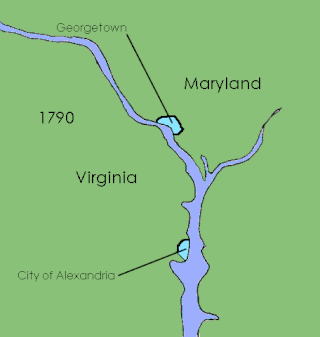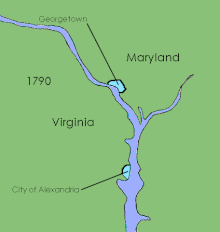
Washington, D.C., formally the District of Columbia and commonly called Washington or D.C., is the capital city and federal district of the United States. The city is on the Potomac River, across from Virginia, and shares land borders with Maryland to its north and east. Washington, D.C., was named for George Washington, a Founding Father and first president of the United States. The district is named for Columbia, the female personification of the nation.

In United States law, an organic act is an act of the United States Congress that establishes a territory of the United States and specifies how it is to be governed, or an agency to manage certain federal lands. In the absence of an organic law a territory is classified as unorganized.

William Cranch was a United States circuit judge and chief judge of the United States Circuit Court of the District of Columbia. A staunch Federalist and nephew of President John Adams, Cranch moved his legal practice from Massachusetts to the new national capital, where he became one of three city land commissioners for Washington, D.C., and during his judicial service also was the 2nd Reporter of Decisions of the Supreme Court of the United States and a Professor of law at Columbian College.

The Council of the District of Columbia is the legislative branch of the government of the District of Columbia. As permitted in the United States Constitution, the district is not part of any U.S. state and is overseen directly by the federal government.

The Residence Act of 1790, officially titled An Act for establishing the temporary and permanent seat of the Government of the United States, is a United States federal statute adopted during the second session of the 1st United States Congress and signed into law by President George Washington on July 16, 1790. The Act provides for a national capital and permanent seat of government to be established at a site along the Potomac River and empowered President Washington to appoint commissioners to oversee the project. It also set a deadline of December 1800 for the capital to be ready, and designated Philadelphia as the nation's temporary capital while the new seat of government was being built. At the time, the federal government operated out of New York City.

District of Columbia home rule is the District of Columbia residents' ability to govern their local affairs. As the federal capital, the Constitution grants the United States Congress exclusive jurisdiction over the District in "all cases whatsoever".

The County of Washington was one of five original political entities within the District of Columbia, the capital of the United States. Formed by the Organic Act of 1801 from parts of Montgomery and Prince George's County, Maryland, Washington County referred to all of the District of Columbia "on the east side of the Potomac, together with the islands therein." The bed of the Potomac River was considered to be part of Washington County as well.
A capital district, capital region, or capital territory is normally a specially designated administrative division where a country's seat of government is located. As such, in a federal model of government, no state or territory has any political or economic advantage relative to the others because of the national capital lying within its borders. A capital territory can be a specific form of federal district.

The history of Washington, D.C., is tied to its role as the capital of the United States. The site of the District of Columbia along the Potomac River was first selected by President George Washington. The city came under attack during the War of 1812 in an episode known as the Burning of Washington. Upon the government's return to the capital, it had to manage the reconstruction of numerous public buildings, including the White House and the United States Capitol. The McMillan Plan of 1901 helped restore and beautify the downtown core area, including establishing the National Mall, along with numerous monuments and museums.

District of Columbia retrocession is the act of returning some or all of the land that had been ceded to the federal government of the United States for the purpose of creating its federal district for the new national capital, which was moved from Philadelphia to what was then called the City of Washington in 1800. The land was originally ceded to the federal government by Virginia and Maryland in 1790. After moving through various stages of federal and state approval, the Virginia portion was returned in March 1847.

The District of Columbia has a mayor–council government that operates under Article One of the United States Constitution and the District of Columbia Home Rule Act. The Home Rule Act devolves certain powers of the United States Congress to the local government, which consists of a mayor and a 13-member council. However, Congress retains the right to review and overturn laws created by the council and intervene in local affairs.
Washington, D.C., is the capital city and federal district of the United States. Below is a list of Washington, D.C.-related articles.
The District of Columbia Organic Act of 1801, officially An Act Concerning the District of Columbia, is an organic act enacted by the United States Congress in accordance with Article 1, Section 8 of the United States Constitution. It formally placed the District of Columbia under the control of the United States Congress and organized the territory within the district into two counties: Washington County to the north and east of the Potomac River and Alexandria County to the west and south. The charters of the existing cities of Georgetown and Alexandria were left in place and no change was made to their status. The common law of both Maryland and Virginia remained in force within the district. A court was established in each of the new counties.

The mayor of the District of Columbia is the head of the executive branch of the government of the District of Columbia. The mayor has the duty to enforce district laws, and the power to either approve or veto bills passed by the D.C. Council. In addition, the mayor oversees all district services, public property, police and fire protection, most public agencies, and the district public school system. The mayor's office oversees an annual district budget of $8.8 billion. The mayor's executive office is located in the John A. Wilson Building in Downtown Washington, D.C. The mayor appoints several officers, including the deputy mayors for Education and Planning & Economic Development, the district administrator, the chancellor of the district's public schools, and the department heads of the district agencies.
The following is a timeline of the history of Washington, D.C., the capital city of the United States.

A referendum on statehood for the District of Columbia was held on November 8, 2016. It was the first referendum on statehood to be held in the district. The District of Columbia was created following the passage of the Residence Act on July 9, 1790, which approved the creation of a national capital, the City of Washington on the Potomac River.

The District of Columbia was created in 1801 as the federal district of the United States, with territory previously held by the states of Maryland and Virginia ceded to the federal government of the United States for the purpose of creating its federal district, which would encompass the new national capital of the United States, the City of Washington. The district came into existence, with its own judges and marshals, through the District of Columbia Organic Act of 1801; previously it was the Territory of Columbia. According to specific language in the U.S. Constitution, it was 100 square miles (259 km2).
More than 405 newspapers were founded in Washington, D.C., during the 18th and 19th centuries. They included daily, weekly, and monthly newspapers, mostly published in English, with a few in German and one in French. Many reported on news of national government affairs, since Washington, D.C., is the capital seat of the United States of America. Thomas Jefferson helped establish some of the early newspapers. During the American Civil War, some newspapers were founded and published in military camps and hospitals within Washington, D.C., including Brookland, Tenleytown, Carver General Hospital, Finley General Hospital, Armory Square Hospital, and Kalorama. Most of these newspapers ceased publication before 1900, but a few survived to the 20th century, including the Evening Star, and at least one to the 21st century: The Washington Post.

The Washington, D.C., Admission Act, often referred to simply as the D.C. Admission Act, is a bill introduced during the 116th United States Congress. The bill would grant Washington, D.C., admission into the Union as a state. The bill was originally introduced in the 116th Congress on January 3, 2019, and was reintroduced on January 4, 2021, and January 9, 2023, in the 117th and 118th Congresses. The United States House of Representatives passed it on April 22, 2021.











